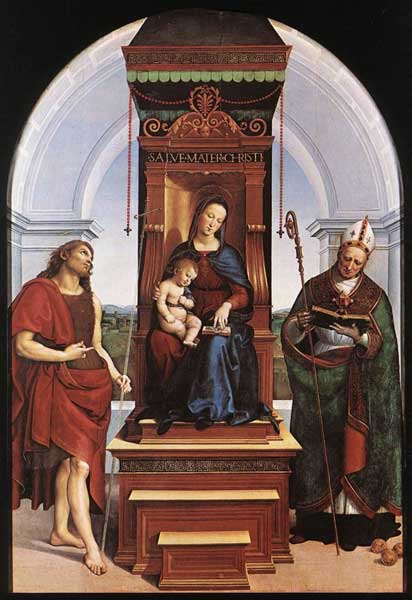Great Works: The Ansidei Madonna 1505 (216.8cm by 147.6cm), Raphael
National Gallery, London

Your support helps us to tell the story
From reproductive rights to climate change to Big Tech, The Independent is on the ground when the story is developing. Whether it's investigating the financials of Elon Musk's pro-Trump PAC or producing our latest documentary, 'The A Word', which shines a light on the American women fighting for reproductive rights, we know how important it is to parse out the facts from the messaging.
At such a critical moment in US history, we need reporters on the ground. Your donation allows us to keep sending journalists to speak to both sides of the story.
The Independent is trusted by Americans across the entire political spectrum. And unlike many other quality news outlets, we choose not to lock Americans out of our reporting and analysis with paywalls. We believe quality journalism should be available to everyone, paid for by those who can afford it.
Your support makes all the difference.Sweetness, harmoniousness, grace. These qualities are not admired as they once were. Imagine them being used as words of praise for a work made in 2011. Are the times out of joint? Discuss. Raphael possessed all these attributes, in varying degrees, in abundance. This early altarpiece was commissioned for a family chapel, and the painting itself simulates a chapel-like space. Its effect is extraordinarily calculated. Raphael knew exactly where he wanted the light to fall, how he wanted to dispose the figures about the space. It is, in short, full of intense geometrical calculation. The arrangement of the figures – with the Mother of God and the chubby babe in the central niche, and then, to left and right, Saint John the Baptist and Saint Nicholas of Bari – feels almost inevitable.
This painting would have been called an example of a sacra conversazione, and yet what is remarkable is that there is no interaction whatsoever between these players. Saint John, extraordinarily youthful and handsome, right leg twisted out in a balletic pose, peers up towards the Latin description of Mary, and, without even looking in his direction, points with crooked finger towards the baby. Mary is intent upon the book that she is holding open for the child's edification – there are many flexed, vigorous fingers in this painting. Saint Nicholas too, utterly self-absorbed, peers down at a sacred text. Everyone seems to be looking at the world through an inward eye – "which is the bliss of solitude", Wordsworth would have continued, had he just been invited to finish the quotation from what was once every schoolchild's best remembered poem.
The painting possesses a remarkable poise, as if it circles about its own still point. There is a Pygmalion effect at work here too, which adds to our sense of the miraculous. Except that the miracle of Pygmalion is reversed. We feel that Mary, posed as she is inside that niche – it looks, when examined close up, slightly sticky, as if it were made from well-sucked toffee – ought to be fashioned from marble. That's what figures in niches are often made from. This marble is alive. It is human flesh plus (in so far as it was recently superhumanly impregnated), and sumptuously adorned. As is John the Baptist, whose camel-hair coat is clearly visible beneath the costly sweep of his fabrics. (That coat is a welcome nod in the direction of poverty and desert thirst.)
These beings may not be present to each other – they do seem somewhat absent in the body – yet, paradoxically, they also manage to occupy this fairly narrow space powerfully and fully. Physically, they are fully grounded in their earthliness. And yet all is light and airiness too. Light dances in from the window space, which frames a view across Raphael's Umbrian countryside. Light also comes in from somewhere above, at the front.
That opening out to the air behind the Virgin and Child in their niche seems odd – imagine some bemused straw-chewer looking in from the fields, and seeing the unvarnished back of it.
ABOUT THE ARTIST
Trained by the painter Perugino, Raphael of Urbino (1483-1520) was Michelangelo's greatest rival, and the older man was intensely jealous of his sweeter-natured and more diplomatic younger rival. Like Michelangelo, Raphael had an extraordinary range of gifts – he was architect, interior decorator, painter and town planner. He died of a fever at an early age. Michelangelo outlived him by nearly five decades, and contrived to make it impossible for Raphael's great cycle of tapestries to be shown as intended in the Sistine Chapel.
Join our commenting forum
Join thought-provoking conversations, follow other Independent readers and see their replies
Comments